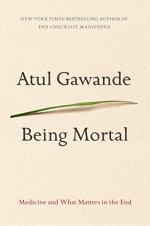
|
| Name: _________________________ | Period: ___________________ |
This test consists of 5 multiple choice questions, 5 short answer questions, and 10 short essay questions.
Multiple Choice Questions
1. By what factor does Gawande say the cost of living in a nursing home exceeds the cost of living in an assisted living facility?
(a) 3.
(b) 7.
(c) 5.
(d) 2.
2. What does Gawande say Laura Carstensen found in terms of people’s values in life?
(a) Your needs depend on how many people you love.
(b) Your needs depend on who needs you.
(c) Your needs depend on how much time you have.
(d) Your needs depend on how much pain you are in.
3. What was Lazaroff’s response to Gawande’s insistence?
(a) He said he was looking forward to seeing his wife in heaven.
(b) He said that he trusted the doctors.
(c) He said that he trusted in God to protect him.
(d) He became adamant about doing everything.
4. What was Gawande’s father’s profession?
(a) Teacher.
(b) Urologist.
(c) Executive.
(d) Engineer.
5. What does Lou Sanders’ daughter Shelley compare him to when he comes to live with her and her family?
(a) A cornered old turtle.
(b) A nervous girl making new friends.
(c) A kid getting on the bus.
(d) A restless dog that cannot settle.
Short Answer Questions
1. What does Gawande say Lou Sanders was scared of?
2. How many hospitals does Gawande say were built after Congress passed the Hill Burton Act, to provide funds for hospital construction?
3. What does Gawande say is the biggest difference between how people age today and how they used to age?
4. What was the event that triggered a readjustment in Felix Silverstone’s life?
5. What does Gawande say older people’s diets tend to be richer in?
Short Essay Questions
1. How does Gawande describe his exposure to training about mortality in medical school?
2. What conclusions does Gawande draw from the case of Joseph Lazaroff?
3. Who was the first person Gawande says he personally witnessed get old and decline?
4. How does Gawande describe the transition from traditional forms of elder care to the (failing) modern forms of care?
5. What critique does Gawande make of his colleagues in the medical field?
6. What are the challenges Gawande describes in Alice Hobson’s declining health?
7. How does Gawande characterize the finances of geriatrics?
8. What happened to Keren Wilson’s vision of assisted living facilities, as the idea took off?
9. When did the experience of aging and dying come home for Gawande?
10. What does Gawande say he learned from Mabel Nassau’s study of elderly people in Greenwich Village?
|
This section contains 1,030 words (approx. 4 pages at 300 words per page) |

|




